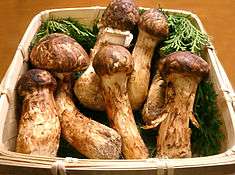Matsutake
Matsutake (Chinese & Japanese:松茸, pine mushroom, Tricholoma matsutake = syn. T. nauseosum) is the common name for a highly sought-after mycorrhizal mushroom that grows in Asia, Europe, and North America. It is prized in Japanese, Korean, and Chinese cuisine for its distinct spicy-aromatic odor.[1][2]
Habitat and distribution
Matsutake grow under trees and are usually concealed under duff on the forest floor free of non-symbiotic trees, e.g. broad-leaved. It forms a symbiotic relationship with the roots of a limited number of tree species. Matsutake are known to grow in China, Japan, Korea, Laos, Canada, Finland, the United States, and Sweden, among other countries. In Japan it is most commonly associated with Japanese red pine.[3]
Similar species
In the North American Pacific Northwest Tricholoma magnivelare is found in coniferous forests made up of one or more of the following species: Douglas fir, Noble Fir, Shasta Red Fir, Sugar Pine, Ponderosa Pine, or Lodgepole Pine. In California and parts of Oregon, it is also associated with hardwoods, including Tanoak, Madrone, Rhododendron, Salal, and Manzanita. In northeastern North America, the mushroom is generally found in Jack Pine forests. T. magnivelare is typically called White Matsutake as it does not feature the brown coloration of the Asian specimen.
In 1999, N. Bergius and E. Danell reported that Swedish (Tricholoma nauseosum) and Japanese matsutake (T. matsutake) are the same species.[4] The report led to increased import of matsutake from Northern Europe to Japan because of the comparable flavor and taste.
Cost and availability

Though simple to harvest, matsutake are hard to find because of their specific growth requirements and the rarity of appropriate forest and terrain, combined with competition from local folk and wild animals such as squirrel, rabbits and deer for the once-yearly harvest of mushrooms, causing the price to be very high at times or as low as $2 per pound for pickers when the market will bear it. Domestic production of matsutake in Japan has been sharply reduced over the last 50 years due to the pine-killing nematode Bursaphelenchus xylophilus, which has influenced the price a great deal. The annual harvest of matsutake in Japan is now less than 1,000 tons, and the Japanese mushroom supply is largely made up by imports from China, Korea, the North American Pacific Northwest (Northern California, Oregon, Washington, and British Columbia), and Northern Europe (Sweden and Finland).[5] The price for matsutake in the Japanese market is highly dependent on quality, availability, and origin. The Japanese matsutake at the beginning of the season, which is the highest grade, can go up to $2,000 per kilogram. In contrast, the average value for imported matsutake is about $90 per kilogram.[6]
See also
- Himematsutake: the "princess matsutake"
- List of Tricholoma species
- Medicinal fungi
References
- ↑ Ashkenazi, Michael; Jacob, Jeanne (2003). Food culture in Japan. Greenwood Publishing Group. p. 49. ISBN 0-313-32438-7.
- ↑ Play That Fungi Music
- ↑ Ashburne, John, "In search of the Holy Grail of mushrooms", Japan Times, 16 October 2011, p. 7.
- ↑ Eric Danell, The Swedish matsutake and the Japanese matsutake are the same species!, The Edible Mycorrhizal Mushroom Research Group, Department of Forest Mycology and Pathology, Swedish University of Agricultural Sciences.
- ↑ (Japanese) 輸入マツタケに異変 中国産激減、フィンランド参戦, J-CAST, 2007/9/26.
- ↑ Matsutani, Minoru, "Japan's long love affair with 'matsutake'", Japan Times, 9 November 2010, p. 3.
External links
| Wikimedia Commons has media related to Tricholoma matsutake. |

